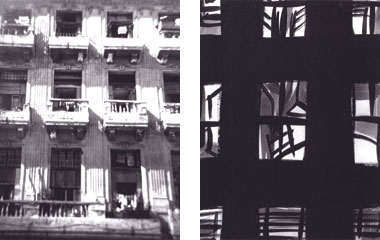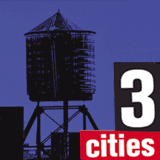 José Picayo, a photographer, grew up in a small town outside of Havana. Tom Slaughter, a painter, has lived in New York's SoHo for decades. Both are fascinated by their home cities, and recently they decided to show their work side-by-side. Topic brought them to Slaughter's studio in mid-January to drink Coca-Cola and discuss art and cities. The complete interview, part of which appeared in Topic 3: Cities, follows below. 
HASKELL: What moved you to combine your art, and whose idea was it? SLAUGHTER: José and I met on a committee to raise money for a scholarship program. We've always liked each other's work, and we trade pieces with each other all the time it's a love fest. We were looking for a project we could do together. PICAYO: I showed him this little flip-book I made with an old camera that makes images that look like family pictures. SLAUGHTER: When I saw this flip-book, it was so anti-digital, anti-laser print. Everything about it was a throwback to when you could smell the picture and you could literally smell these Polaroids. When I saw the rooftops in Havana, I said, "Man, I got a picture just like that from looking across the projects." PICAYO: In a way it's almost like his New York and my Havana. HASKELL: José, when you take pictures of Havana, what are you looking for? What makes it your place? PICAYO: I like things about it that don't perfectly go there. You've got five cities in one: sometimes it looks like Venice without the water, some parts look Paris, some parts look like the modern sections of San Juan, and Madrid also. So it's all these different cities in one. And Havana architecture is its own thing too. They call their architecture "three different styles in one." They can't even say what it is. So when I see it, it's very dreamy. It's very different than any city I've been in. It's what I remember of it. SLAUGHTER: But kind of romantic too, the way that New York is. If you're going to make a movie, and you want instant art direction, you've got to go to a real place. You can't make Toronto look like New York, and you can't make Puerto Rico necessarily look like Havana. There's a time warp in both these places. You take away the new cars in New York and you can use New York for a 1955 movie. I don't think you have to change anything in Havana for a 1955 movie because the cars are the same. The feeling is the same. 
HASKELL: What is it that each of you find so captivating about the urban icons like the rooftops, the water towers, and the windows that resurface in your work? SLAUGHTER: The wooden water tower is unique in New York. Every building over six stories requires a water tower, so the water is pumped up there and then distributed throughout the rest of the building or used to store water for the sprinkler systems. They perform a dance on top of these buildings. PICAYO: I've seen so many Cuba books that are coffee table books, garbage, tourist books. All the pictures are the same: the waterfront, this and that. I was trying to find things that attract me. I was up in a building looking down on rooftops, and it was different from what you are used to seeing there or anywhere else. In New York you're used to the fancy water tower, but here's this water tower that looks like it doesn't even work. But it still works, and in Cuba everything works. They make it work. You open a car and the engine is not the car's engine, it's some Japanese car whatever the hell they found to make it work. The buildings are falling apart, but people are living in them. And no matter what they try to do to them, the buildings still survive. SLAUGHTER: It's a lot like New York that way. I'm not talking about the New York of skyscrapers... PICAYO: It's things about the cities that you wouldn't look at. SLAUGHTER: The back window is more interesting. PICAYO: It's more what I remember doing, which is what people would do every day: wash their clothes in the sink. Very basic things to survive. HASKELL: But people live everywhere. What is it about living in cities that is aesthetically captivating for you? Would you ever be able to be a rural artist? SLAUGHTER: We both are very fortunate to taste both worlds. José is a fantastic gardener and has a place up the Hudson river, and I have a summer place in southern Ontario. They both have their pleasures, but when you're young and have the energy, there's nothing like the urban environment. Everything else is slack. You just can't compare. They don't dance until four in the morning in Stratford, Ontario. If you've got the strength, this is the place. HASKELL: Granted all art is elemental, and there's the opportunity to focus on certain things and ignore others. But still, in these images, where are the people? SLAUGHTER: In my case I often return to an iconic image a building façade, a water tower or something like that that is without people, because sometimes people can add sentimentality to a picture. If you're painting the light, you're just painting the light. It's like Edward Hopper. His pictures are very lonely, but it's not the people in them that makes them lonely; it's the fact that he painted a shadow on the wall. He evoked a feeling of loneliness. Painting a picture of a lonely guy is sentimental, and these are not sentimental pictures. 
HASKELL: Is Cuba captivating because it's standing still, and New York because it's changing so fast? PICAYO: I think Havana is growing in other senses, as far as its culture and its people and what happens there. The film festival, writing and music. (A lot of the music that comes out is the old-style music, but there are tons of the modern). There's a lot of progress there. SLAUGHTER: On the other hand, on the island of Manhattan, things don't change that radically. There's not going to be any urban sprawl; there's not going to be track housing. The Lower East Side pretty much still looks like the Lower East Side of 1960. At St. Mark's Place, the signs change but the buildings are the same. Visually, viscerally, the city still has this wonderful feeling that is impossible almost impossible to destroy. PICAYO: It's like the West Village. My building is from 1836, and it's still there. When you think about it: 1836, what was going on? At the time, this was the only building on the street. The others were 1840-something... SLAUGHTER: Latecomers! The building we're in now is 105 years old and used to be the Tiffany's department store. It's now Banana Republic. Things change but things stay the same. HASKELL: A few decades ago, SoHo was slated for demolition. Now, of course, it's one of the hottest neighborhoods in New York and clearly safe from the wrecking ball. But in the attempt to save the neighborhood, are we losing it? Would you move here now if you were... SLAUGHTER: No way! You can't walk down the street! Get out of the way! My daughter thinks "fucking New Jersey driver" is all one word. But then, we're living in what used to be a real art community and is now basically a shopping mall. PICAYO: Even the Village is like that. It's all turned into one-family brownstones, and NYU owns a lot of them, and on top of that all these people started buying and converting them. So the money has changed. The old people get kicked out. SLAUGHTER: What do they do with the old people? PICAYO: Buy them off? I don't know. HASKELL: So are you saying that even New York is becoming a theme park? SLAUGHTER: Do you think that when people go to Vegas think they've been to Paris or New York? PICAYO: Or Egypt? SLAUGHTER: One wonders. When they stand in front of the Eiffel Tower... PICAYO: Yes they do! They do. People go to Europe on a bus ten cities in five days and then say, "I went to Holland! I was in Amsterdam for an afternoon!" SLAUGHTER: Going to New York can be that way. Tour buses are hysterical. You wave to these people like we're the animals they're the normal ones and we're the freak show. Is New York a theme park? It's a bit of a theme park. 
HASKELL: Maybe it's just because I'm young, but I would argue that it's never been a better time to live in New York. There are more people living here than ever before. The city is witnessing the largest immigration in its history. Little Italy may be disappearing, but a few blocks from here I paid a dollar for noodles in Chinatown. What's wrong? Isn't that urban life? SLAUGHTER: You know what? Damn it, you're one hundred percent right. And that's why we're here. Because we still love it. We're just being old farts, sitting around here complaining. PICAYO: There's still no other place. Photographs by José Picayo. Paintings by Tom Slaughter.
Back to Top | More Extras | Subscribe to Topic
 | 
